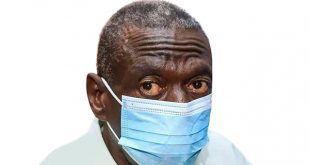
By Abushede Angella
People should also cover their mouths when sneezing or coughing
The hospitalisation of former South African President, Nelson Mandela has once again drawn attention to the medical challenge posed by lung infections among the elderly. Mandela is 94-years old.
He was rushed from his home in Johannesburg by ambulance after experiencing breathing difficulties and his current hospitalisation is the fourth time in just over six months and the third already this year. Mandela’s condition is what doctors generally group as Respiratory Tract Infections (RTIs).
Respiratory Tract Infections have become a common illnesses,” says Dr Ssekyewa Desmond, a general practitioner at Kampala Hospital.

The respiratory tract is the passage formed by the mouth, nose, throat and lungs through which air passes during the breathing process while RTIs are any infections of the sinuses, throat, airways or lungs.
They are usually caused either by viruses or bacteria and sometimes fungi. Viral infections include sinusitis, pharyngitis, laryngitis and otitis media. The bacterial are pneumonia and whooping cough.
RTIs can spread in several ways. If you have an infection such as a cold, tiny droplets of fluid containing the cold virus are launched into the air whenever you sneeze or cough. If these are breathed in by someone else, they may also become infected. Infections can also be spread through indirect contact.
I you have a cold and you touch your nose or eyes before touching an object or surface, the virus may be passed to someone else when they touch the object or surface.
Dr Ssekyewa says RTIs are classified into infections of the upper respiratory tract and infections of the lower tract.
“The upper tract infections affect the nose, sinuses, larynx, tonsils and throat,” he says. These include tonsillitis; an infection of the tonsils and tissues at the back of the throat, common cold, sinusitis; infection of the sinuses, otitis; middle ear infections, and laryngitis; infection of the larynx or voice box.
The infections of the lower tract affect the lungs and the airways and include bronchitis; infection of the airways, pneumonia; infection of the lungs, bronchiolitis; infection of small airways that affects babies; and tuberculosis, which is the persistent bacterial infection in the lungs.
While cough is the commonest type of upper RTI, it is the common symptom of the lower UTI. It is usually severe causing a tight feeling in the chest and wheezing.
Other signs and symptoms of respiratory infections include fever, increased shortness of breath (dyspnea), changes in mucus (increases in amount, thickens and changes in color), pleuritic chest pains and headaches among others.
Although anyone is at risk, Ssekyewa says, “The elderly and young children who are less than five are more susceptible to RTIs because their immunity is too weak to many viruses.”
Other people prone to RTIs include those born with heart or circulatory problems and people with long term health problems such as diabetes and kidney problems. Pregnant women, obese and asthmatic people, smokers both passive and active, painters, and workers in quarrying fields are vulnerable.
Dr Ssekyewa says the number of people seeking treatment at the hospital for respiratory related infections is increasing and they have recently lost a painter due to lung infection.
Most of these are vulnerable because they work in dusty or gaseous conditions and when the gases, dust or small objects enter the lungs, they cover the alveoli sacs, and make breathing difficult.
Mandela picked up tuberculosis when he was jailed at the notorious Robben Island prison and subjected to manual labour including breaking up phosphorous stones. The infection might have left scars in the lungs that could be causing the recurring lung infection.
Dr Ssekyewa companies and people dealing in painting, stone quarrying and mining to take care of their employees by providing protective gear to prevent these foreign objects from entering their bodies.
Signs of respiratory infections include fever, increased shortness of breath (dyspnea), changes in mucus (increases in amount, thickens and changes in color), pleuritic chest pains and headaches among others.
Although most RTIs get better without any treatment, in case of medication, treatment depends on the type of infection, its cause, symptoms, and risk of complications of the infection. Anti biotics are not recommended because they are only effective in treating only infections caused by bacteria.
Dr Ssekyewa advises that to prevent RTIS people should regularly wash their hands with soap particularly before preparing and eating food, throw away tissue in a safe place after blowing your nose, coughing and sneezing.
“People should also cover their mouths when sneezing or coughing and should also keep their hands away from your eyes, nose and mouth. People should avoid sharing cups, glasses and cutlery when eating or drinking and keep household surfaces clean.”
He also recommends drinking plenty of fluids and having a balanced diet as good nutrition helps the body resist infections.
 The Independent Uganda: You get the Truth we Pay the Price
The Independent Uganda: You get the Truth we Pay the Price


